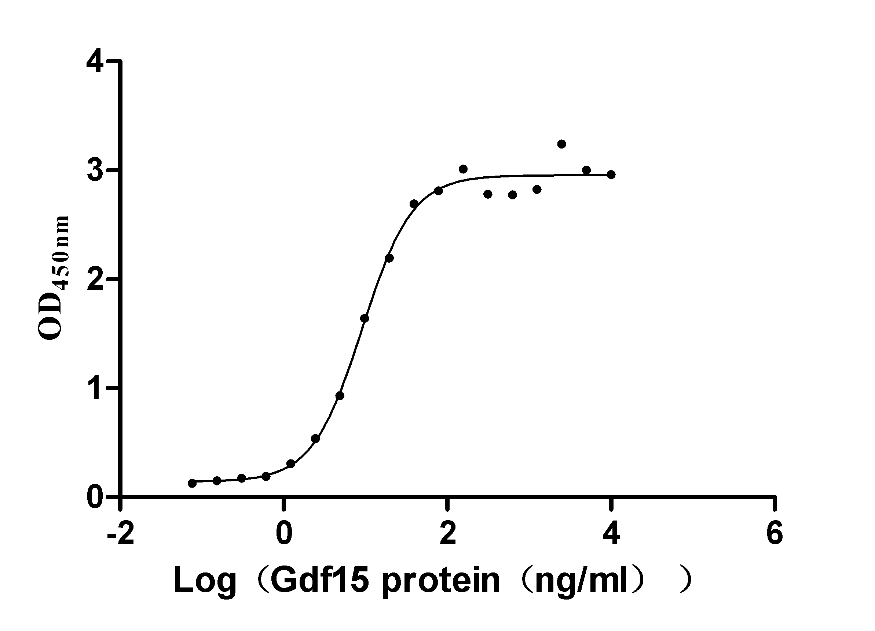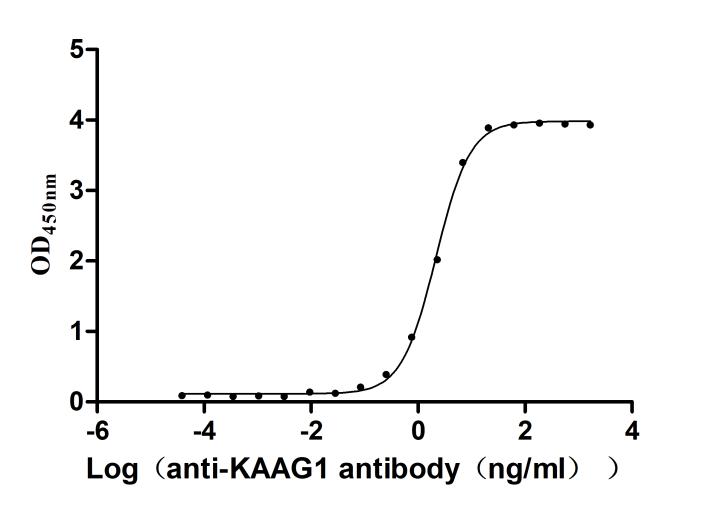Recombinant Rat Vesicular glutamate transporter 3 (Slc17a8), partial
-
货号:CSB-YP763188RA
-
规格:
-
来源:Yeast
-
其他:
-
货号:CSB-EP763188RA-B
-
规格:
-
来源:E.coli
-
共轭:Avi-tag Biotinylated
E. coli biotin ligase (BirA) is highly specific in covalently attaching biotin to the 15 amino acid AviTag peptide. This recombinant protein was biotinylated in vivo by AviTag-BirA technology, which method is BriA catalyzes amide linkage between the biotin and the specific lysine of the AviTag.
-
其他:
-
货号:CSB-BP763188RA
-
规格:
-
来源:Baculovirus
-
其他:
-
货号:CSB-MP763188RA
-
规格:
-
来源:Mammalian cell
-
其他:
产品详情
-
纯度:>85% (SDS-PAGE)
-
基因名:
-
Uniprot No.:
-
别名:Slc17a8; Vglut3; Vesicular glutamate transporter 3; VGluT3; Solute carrier family 17 member 8
-
种属:Rattus norvegicus (Rat)
-
蛋白长度:Partial
-
蛋白标签:Tag type will be determined during the manufacturing process.
The tag type will be determined during production process. If you have specified tag type, please tell us and we will develop the specified tag preferentially. -
产品提供形式:Lyophilized powder
Note: We will preferentially ship the format that we have in stock, however, if you have any special requirement for the format, please remark your requirement when placing the order, we will prepare according to your demand. -
复溶:We recommend that this vial be briefly centrifuged prior to opening to bring the contents to the bottom. Please reconstitute protein in deionized sterile water to a concentration of 0.1-1.0 mg/mL.We recommend to add 5-50% of glycerol (final concentration) and aliquot for long-term storage at -20℃/-80℃. Our default final concentration of glycerol is 50%. Customers could use it as reference.
-
储存条件:Store at -20°C/-80°C upon receipt, aliquoting is necessary for mutiple use. Avoid repeated freeze-thaw cycles.
-
保质期:The shelf life is related to many factors, storage state, buffer ingredients, storage temperature and the stability of the protein itself.
Generally, the shelf life of liquid form is 6 months at -20°C/-80°C. The shelf life of lyophilized form is 12 months at -20°C/-80°C. -
货期:Delivery time may differ from different purchasing way or location, please kindly consult your local distributors for specific delivery time.Note: All of our proteins are default shipped with normal blue ice packs, if you request to ship with dry ice, please communicate with us in advance and extra fees will be charged.
-
注意事项:Repeated freezing and thawing is not recommended. Store working aliquots at 4°C for up to one week.
-
Datasheet :Please contact us to get it.
相关产品
靶点详情
-
功能:Mediates the uptake of glutamate into synaptic vesicles at presynaptic nerve terminals of excitatory neural cells. May also mediate the transport of inorganic phosphate.
-
基因功能参考文献:
- Chronic voluntary wheel running results in increased gene expression of VGLUT3 (and GLT-1) in the frontal cortex without changes in other glutamate transporter subtypes. PMID: 29375045
- VGLUT3 is involved in the pathogenesis of visceral hyperalgesia in a rat model of irritable bowel syndrome. PMID: 25780293
- VGLUT3 likely has developmental and physiological roles in the rat cochlea during postnatal development as well as later in life PMID: 24064385
- The results of this study rat brains showing that small, clear, and round synaptic vesicles in gamma-aminobutyric acid (GABA)-ergic nerve terminals contain labeling for both VGLUT3 and the vesicular GABA transporter . PMID: 23633129
- VGLUT3-immunoreactive boutons in the lateral sinus form two different, disproportionate, populations of synaptic contacts with their target neurons. PMID: 22374223
- VGLUT3 localizes to a distinct set of synaptic-like microvesicles in perisynaptic astroglial processes and may be important for glutamate release from astrocytes. PMID: 22573606
- The periodontal Ruffini endings of rat incisors show both VGluT1 and VGluT2, and lack VGluT3. PMID: 21957077
- projections between the arcuate nucleus and ventrolateral periaqueductal gray are available to participate in prolonged modulation by electroacupuncture and that VGLUT3-containing neurons are an important neuronal phenotype involved in this process PMID: 20836994
- These results suggest that VGLUT3-expressing nonserotonergic neurons in the midbrain raphe nuclei are preferentially distributed in the DRDSh and modulate many brain regions with the neurotransmitter glutamate via ascending axons. PMID: 20034056
- Taken together, these findings indicate locally collateralizing glutamate neurons responsive to substance P contain VGLUT3. PMID: 19467322
- dendritic expression of VGLUT3 by particular neurons also indicates the potential for retrograde synaptic signaling PMID: 12388773
- In the rat retina, the dendrites of vGluT3 amacrine cells form a dendritic tree that is bistratified in the inner plexiform layer. The vGluT3 cells have a dendritic overlap and form a regular mosaic, suggesting a single type of amacrine cell. PMID: 14648683
- Weak expression of VGLUT3 mRNA is only detected in deep laminae of lumbar spinal cord. PMID: 14681932
- Neurons containing VGLUT3 transcript are essentially observed in the caudate-putamen, the olfactory tubercle, the nucleus accumbens, the hippocampus, the interpeduncular nucleus and the dorsal and medial raphe nuclei. PMID: 14751290
- The results suggest that boutons coexpressing VGLUT3, CCK and GAD originate from CCK-positive basket cells, which are VIP-immunonegative. PMID: 14984406
- VGLUT3-expressing GABAergic interneurons form a chemically specific circuit within the preprotachykinin B-producing interneuron group. PMID: 15142960
- The developmental pattern of Vglut3 in the olivary nucleus was studied. PMID: 15714284
- These findings support our hypothesis that neurons and fibers containing VGLUT3 lie in close proximity to those containing nNOS and that both proteins colocalize in some neurons and fibers in the NTS. PMID: 15820620
- Between P1 and P15, VGLUT3 is observed in the frontal brain and in the caudal brain During a second phase extending from P15 to adulthood, the labeling of the caudal brain fades away. The adult pattern is reached at P21. PMID: 16182324
- VGLUT3 identifies a novel excitatory terminal subset that contributes to the tuning of DA cell excitability in the substantia nigra. PMID: 16519671
- Intense VGluT3 immunoreactivity was detected in large number of sensory epithelia cells PMID: 17612597
- The present study shows that midbrain raphe-derived 5-HT fibers can be classified into two subtypes depending on co-expression with VGLUT3 staining in the forebrain. PMID: 18222609
- Expression of VGLUT3 was first observed at postnatal day 10 (P10) in amacrine cell soma and some processes, which extensively arborized in both the ON and OFF sublamina of the inner plexiform later by P15. PMID: 18482716
- distribution of VGLUT3-ir structures in the lateral septum were systematically analyzed revealing PMID: 18611437
- A large number of retrogradely labeled cells in the caudal linear and interpeduncular nuclei projecting to the medial septum are found to contain VGLUT3. PMID: 18925658
- VGLUT3 is localized within neurons containing the NK1 receptor in several areas of the forebrain. PMID: 19699779
显示更多
收起更多
-
亚细胞定位:Cytoplasmic vesicle, secretory vesicle, synaptic vesicle membrane. Membrane; Multi-pass membrane protein. Cell junction, synapse, synaptosome.
-
蛋白家族:Major facilitator superfamily, Sodium/anion cotransporter family, VGLUT subfamily
-
组织特异性:Expressed in brain, kidney and liver. Expressed within the amygdala, brainstem, cerberal cortex, dorsal root ganglia, dorsal spinal cord, hippocampus, hypothalamus, retina, striatum and ventral spinal cord. Expressed within neurons of the caudate-putamen,
-
数据库链接:
KEGG: rno:266767
STRING: 10116.ENSRNOP00000010207
UniGene: Rn.84876
Most popular with customers
-
Recombinant Human Pro-neuregulin-1, membrane-bound isoform (NRG1), partial (Active)
Express system: Mammalian cell
Species: Homo sapiens (Human)
-
Recombinant Human Tumor necrosis factor ligand superfamily member 9 (TNFSF9), partial (Active)
Express system: Mammalian cell
Species: Homo sapiens (Human)
-
Recombinant Mouse GDNF family receptor alpha-like (Gfral), partial (Active)
Express system: Mammalian cell
Species: Mus musculus (Mouse)
-
Recombinant Mouse Tyrosine-protein kinase Mer (Mertk), partial (Active)
Express system: Mammalian cell
Species: Mus musculus (Mouse)
-
Recombinant Human C-type lectin domain family 4 member C (CLEC4C), partial (Active)
Express system: Mammalian cell
Species: Homo sapiens (Human)
-
Recombinant Human Killer cell immunoglobulin-like receptor 3DL2 (KIR3DL2), partial (Active)
Express system: Mammalian cell
Species: Homo sapiens (Human)
-
Recombinant Human Kidney-associated antigen 1(KAAG1) (Active)
Express system: E.coli
Species: Homo sapiens (Human)


-AC1.jpg)
















